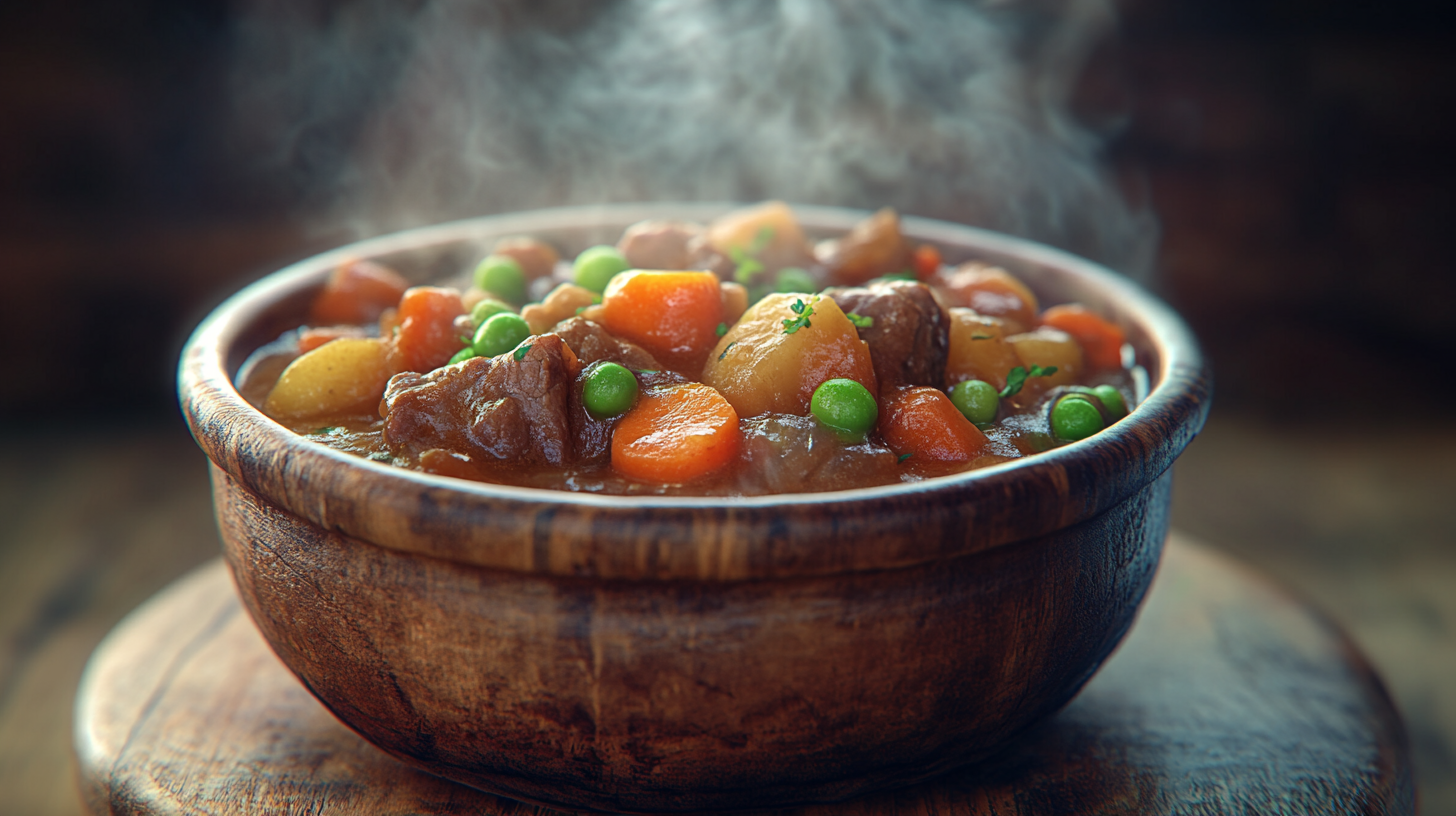Dinty Moore Beef Stew recipe is a household name when it comes to hearty, ready-to-eat comfort food. This classic canned stew has been a staple for generations, offering a quick and filling meal packed with tender beef, potatoes, carrots, and a rich gravy. While the store-bought version is convenient, making it at home allows you to enjoy a fresher, healthier, and more flavorful version without preservatives or artificial additives.
This homemade recipe recreates the rich, savory taste of Dinty Moore Beef Stew using high-quality ingredients and simple cooking techniques. Whether you prepare it on the stovetop, slow cooker, or Instant Pot, this dish delivers deep, slow-cooked flavors and melt-in-your-mouth beef.
In this guide, we’ll cover everything you need to know about making the perfect beef stew, including the best cuts of meat, cooking tips, and variations to suit your preferences.
Table of Contents
What is Dinty Moore Beef Stew recipe?
Dinty Moore Beef Stew is a canned beef stew brand produced by Hormel Foods, first introduced in 1935. Known for its thick gravy, tender beef chunks, and soft vegetables, it became popular as an easy meal that requires no preparation.
Key Features of the Original Canned Stew
- Pre-cooked and shelf-stable – no refrigeration needed.
- Chunks of beef, potatoes, and carrots in a thick, brown gravy.
- Convenient and ready in minutes – just heat and serve.
- Popular among campers, busy families, and those seeking a quick, hearty meal.
While the canned version is beloved, it often contains preservatives, high sodium levels, and artificial flavors. A homemade version gives you full control over the ingredients, allowing for a fresher and healthier alternative.
Why Make a Homemade Version?
Homemade Dinty Moore Beef Stew offers several benefits over the canned variety, including:
1. Better Taste and Texture
Homemade stew features real, fresh ingredients that bring out deeper, richer flavors. The beef is more tender, the vegetables retain their shape, and the gravy is thicker and more flavorful.
2. No Preservatives or Artificial Ingredients
The canned version contains preservatives, flavor enhancers, and high sodium levels to prolong shelf life. A homemade stew allows you to use all-natural ingredients for a cleaner, healthier meal.
3. Customizable to Your Preference
- Prefer leaner beef? Use sirloin instead of chuck roast.
- Want more vegetables? Add mushrooms, peas, or green beans.
- Need a low-sodium option? Control the salt level by making your own broth.
4. Healthier and More Nutritious
By using fresh grass-fed beef, organic vegetables, and homemade broth, you can increase nutrients and reduce unhealthy additives.
If you’re looking for a different take on classic beef stew, try this flavorful twist with our Hawaiian Beef Stew Recipe – a great way to introduce variations of beef stew with tropical influences.
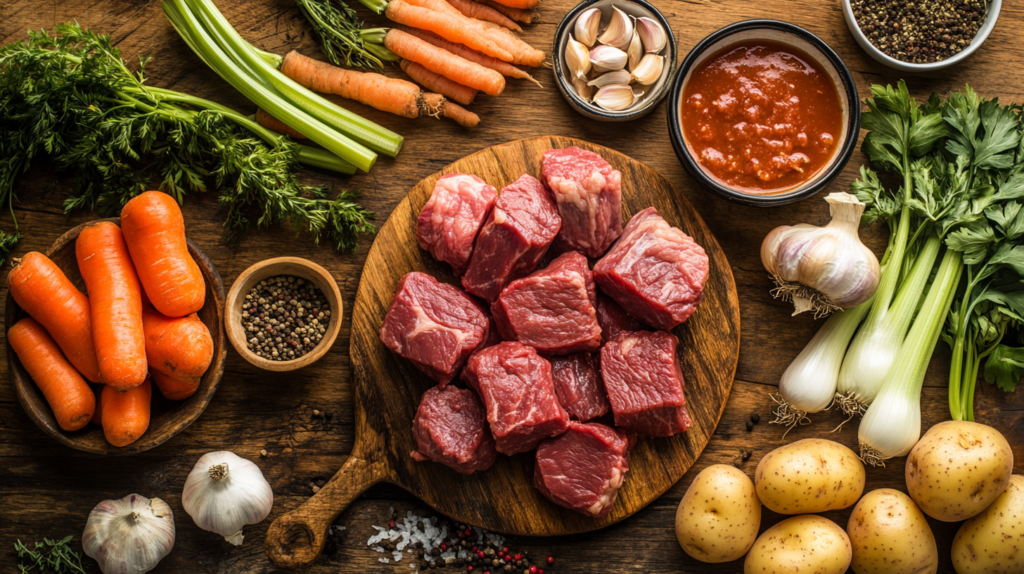
Essential Ingredients for Homemade Dinty Moore Beef Stew
1. Beef – The Star Ingredient
The best cuts for beef stew are tougher cuts that become tender when slow-cooked, such as:
- Chuck roast – The most popular choice, rich in flavor and marbling.
- Brisket – Adds a deeper, beefier taste but requires longer cooking.
- Short ribs – Extremely tender but more expensive.
- Round roast – Leaner, but works well when cooked properly.
2. Vegetables – Classic Stew Ingredients
- Potatoes – Russet or Yukon Gold for a creamy texture.
- Carrots – Adds sweetness and color.
- Celery – Provides a mild, aromatic base.
- Peas – Traditionally added near the end for a pop of color.
3. Broth and Seasoning
- Beef broth – Homemade or low-sodium store-bought for better control of salt.
- Tomato paste – Adds a rich umami depth.
- Worcestershire sauce – Enhances the beefy flavor.
- Bay leaves, thyme, and black pepper – Essential herbs and spices.
A rich and flavorful stew starts with a good broth. Check out our guide on Delicious Recipes Using Beef Broth to enhance your homemade stew with depth and aroma.
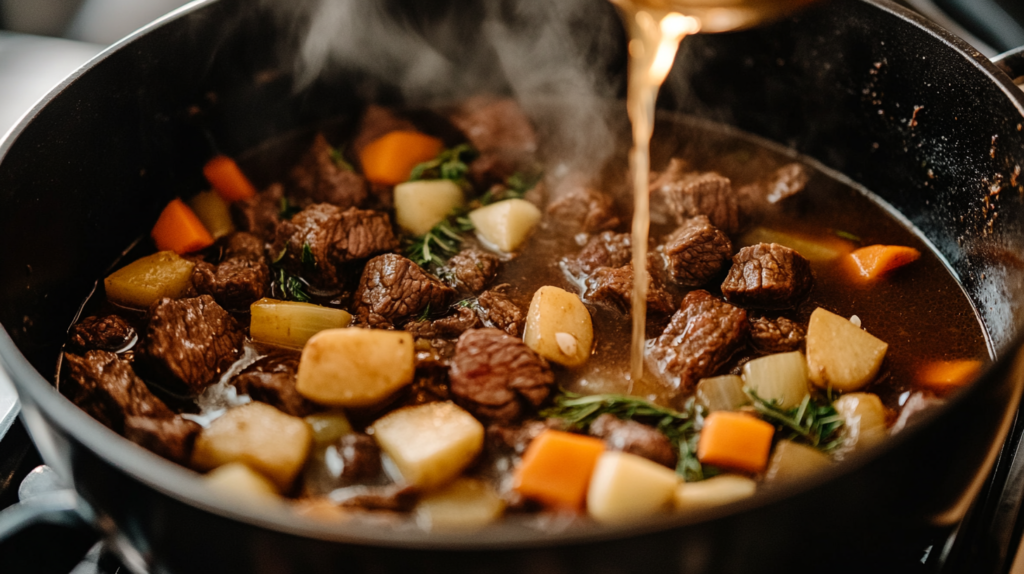
Step-by-Step Recipe: How to Make Homemade Dinty Moore Beef Stew
This homemade beef stew recipe is easy to follow and results in a rich, hearty, and flavorful dish. Below, you’ll find detailed step-by-step instructions to ensure perfect results every time.
Ingredients
For the Stew:
- 2 lbs chuck roast, cut into 1-inch cubes
- 2 tbsp vegetable oil
- 1 medium onion, chopped
- 3 cloves garlic, minced
- 3 cups low-sodium beef broth
- 1 cup water
- 2 tbsp tomato paste
- 1 tbsp Worcestershire sauce
- 1 tsp salt (adjust to taste)
- ½ tsp black pepper
- 1 tsp dried thyme
- 1 bay leaf
- 4 medium potatoes, peeled and cut into chunks
- 3 carrots, peeled and sliced
- 2 stalks celery, chopped
- 1 cup frozen peas
For Thickening:
- 2 tbsp flour or cornstarch
- 3 tbsp cold water
Step 1: Preparing the Ingredients
- Cut the beef into 1-inch cubes, trimming off excess fat.
- Chop the vegetables: Peel and cut the potatoes, slice the carrots, and chop the celery.
- Prepare the broth: Mix the beef broth, Worcestershire sauce, tomato paste, and seasonings in a bowl.
Step 2: Browning the Beef for Rich Flavor
- Heat 2 tbsp of vegetable oil in a large Dutch oven or heavy pot over medium-high heat.
- Add the beef cubes in batches (avoid overcrowding) and sear each side until browned (about 3 minutes per side).
- Remove the browned beef and set it aside.
Browning the beef first creates a deep, rich flavor in the stew by caramelizing the meat’s surface.
Step 3: Building the Stew Base
- In the same pot, add the chopped onions and garlic, cooking for about 2 minutes until softened.
- Pour in a little beef broth to deglaze the pot, scraping up any browned bits from the bottom.
- Return the seared beef to the pot and pour in the remaining broth mixture.
- Add the bay leaf and thyme for extra depth of flavor.
Step 4: Simmering for Tender Meat
- Bring the stew to a gentle boil, then reduce the heat to low.
- Cover and simmer for 1.5 to 2 hours, stirring occasionally.
- After about 1 hour, check the beef for tenderness.
Simmering low and slow ensures the meat becomes fall-apart tender and the flavors meld together.
Step 5: Adding Vegetables at the Right Time
- Once the beef is tender, add potatoes, carrots, and celery to the pot.
- Continue simmering for 30–40 minutes, or until the vegetables are fork-tender.
- Stir in frozen peas 5 minutes before serving.
Step 6: Thickening the Stew
- In a small bowl, mix 2 tbsp of flour or cornstarch with 3 tbsp of cold water until smooth.
- Slowly stir the mixture into the stew and cook for 5–10 minutes until the gravy thickens.
This step ensures the stew has a rich, thick texture without being too heavy.
Step 7: Final Adjustments and Serving
- Remove the bay leaf and taste for seasoning, adding more salt or pepper if needed.
- Serve hot with fresh bread, cornbread, or rice for a complete meal.
Letting the stew rest for 10 minutes before serving helps the flavors develop even more.
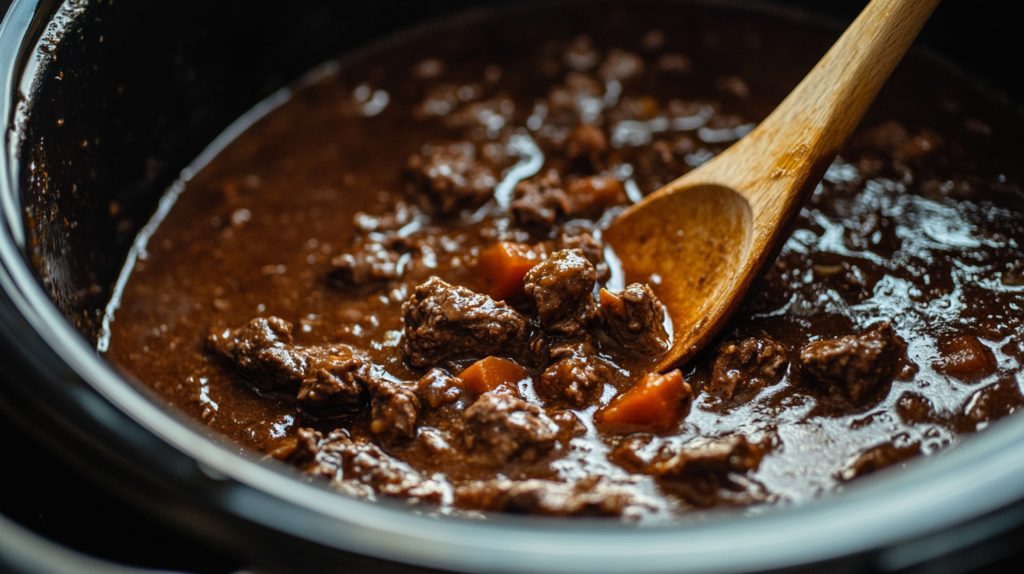
Slow Cooker vs. Stovetop: Which is Better?
Homemade beef stew can be prepared using different methods, each offering its own benefits. Below is a comparison of the stovetop and slow cooker (Crock-Pot) methods to help you decide which works best for you.
Stovetop Method (Classic and Quickest Way)
- Cooking Time: 2 to 2.5 hours
- Best For: Those who want a quicker stew with a deep, slow-cooked flavor.
- How It Works: The stew simmers over low heat in a Dutch oven or heavy-bottomed pot, allowing the beef to become tender while the flavors develop.
Pros:
✔ Faster than a slow cooker
✔ Richer flavor due to better evaporation and browning
✔ Easy to adjust seasoning as it cooks
Cons:
✘ Requires occasional stirring and monitoring
✘ Higher risk of sticking or burning if not watched
Slow Cooker (Crock-Pot) Method (Set-It-and-Forget-It)
- Cooking Time: 6–8 hours on low or 4–5 hours on high
- Best For: Those who prefer a hands-off approach and a meal ready by dinnertime.
- How It Works: The ingredients are added to the slow cooker and left to cook at a low, consistent temperature, resulting in ultra-tender beef.
Pros:
✔ Completely hands-off once assembled
✔ Beef becomes incredibly soft and flavorful
✔ No need for constant stirring
Cons:
✘ Takes longer to cook
✘ Slightly thinner broth compared to stovetop (can be thickened at the end)
How to Adapt the Recipe for a Slow Cooker
- Sear the beef first in a skillet for extra flavor.
- Transfer the browned beef, onions, garlic, broth, and seasonings to the slow cooker.
- Cook on low for 8 hours or high for 4–5 hours.
- Add potatoes and carrots in the last 2 hours to prevent them from overcooking.
- Stir in frozen peas in the final 10 minutes before serving.
For a thicker stew, mix cornstarch with water and stir it in during the last 30 minutes of cooking.
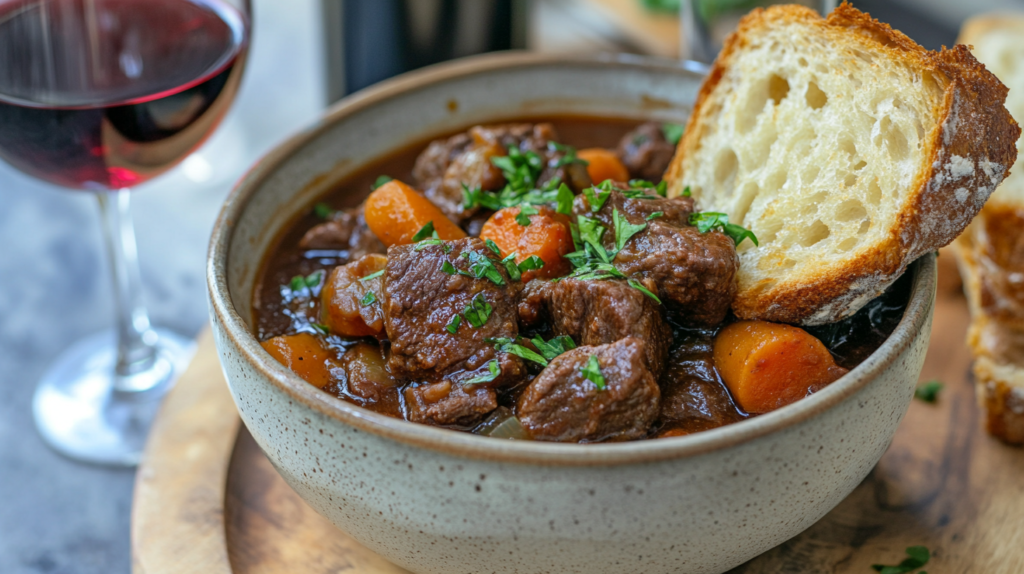
Pro Tips for the Best Homemade Beef Stew
To make your homemade beef stew truly exceptional, follow these expert tips:
1. Choose the Right Cut of Beef
- Chuck roast is the best choice because of its fat content and tenderness after slow cooking.
- Avoid leaner cuts like sirloin, as they can become tough and dry.
2. Brown the Meat First
- Searing the beef before simmering creates a deeper, richer flavor.
- Don’t overcrowd the pan when browning, or the meat will steam instead of sear.
3. Add Vegetables at the Right Time
- Potatoes, carrots, and celery should be added after the beef has cooked for at least an hour.
- Adding them too early makes them mushy and overcooked.
4. Use Low-Sodium Broth
- Store-bought beef broth can be very salty, so opt for low-sodium versions or homemade broth.
- This allows you to control the seasoning better.
5. Let the Stew Rest Before Serving
- Allowing the stew to sit for 10–15 minutes after cooking helps the flavors deepen.
- Leftovers taste even better the next day as the ingredients meld together.
For more hearty meals like this, explore our collection of Easy Beef Recipes perfect for any occasion.
Variations and Customizations
Want to make your beef stew unique? Try these variations:
1. Low-Carb/Keto Version
- Replace potatoes with cauliflower, turnips, or radishes for a lower-carb option.
- Use almond flour or xanthan gum instead of cornstarch for thickening.
2. Spicy Beef Stew
- Add ½ teaspoon of chili flakes or hot sauce for extra heat.
- A dash of smoked paprika adds a mild, smoky spice.
3. Gluten-Free Option
- Use cornstarch instead of flour for thickening.
- Ensure Worcestershire sauce is gluten-free (some brands contain wheat).
4. Instant Pot (Pressure Cooker) Method
- Sear the beef using the Sauté function.
- Add broth, seasonings, and veggies, then cook on high pressure for 35 minutes.
- Release pressure naturally for 10 minutes before opening.
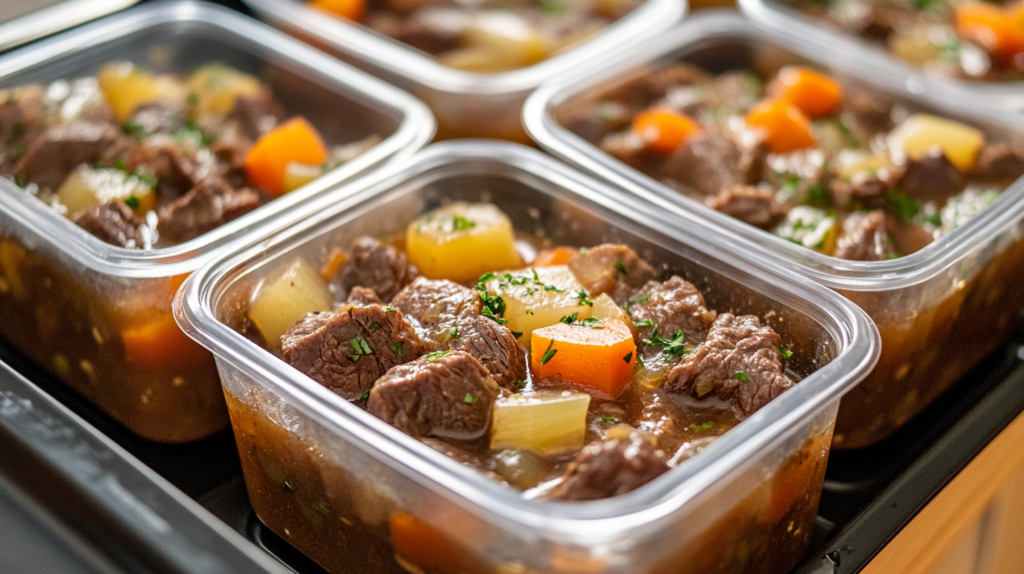
How to Store and Reheat Beef Stew
Homemade beef stew is a great make-ahead meal because it tastes even better the next day. Proper storage and reheating help maintain its rich flavors and thick consistency.
Refrigeration
- Allow the stew to cool completely before storing.
- Transfer to an airtight container and refrigerate for up to 4 days.
Freezing Instructions
- Freeze in portion-sized containers for easy reheating.
- Beef stew can be frozen for up to 3 months.
- Avoid freezing potatoes, as they can become mushy. If needed, add fresh potatoes when reheating.
Reheating Methods
On the Stovetop (Best for Large Portions)
- Transfer the stew to a pot over medium heat.
- Add a splash of water or broth if it has thickened too much.
- Simmer for 10–15 minutes, stirring occasionally.
In the Microwave (Best for Single Servings)
- Place a portion in a microwave-safe bowl.
- Cover loosely and heat in 1-minute intervals, stirring between each.
- Add a bit of broth or water if needed.
In the Slow Cooker (Best for Batch Reheating)
- Place the stew in the slow cooker on low for 2 hours, stirring occasionally.
For the best taste and texture, avoid boiling the stew when reheating.
What to Serve with Dinty Moore Beef Stew?
A hearty beef stew is a complete meal, but pairing it with the right sides can enhance the experience.
1. Bread and Rolls
- Crusty French bread for dipping
- Buttermilk biscuits for a soft, buttery addition
- Garlic bread for extra flavor
2. Rice or Pasta
- Serve over steamed rice for a heartier meal
- Pair with egg noodles for a beef stroganoff-style twist
3. Vegetables and Salads
- A simple green salad with a light vinaigrette
- Roasted Brussels sprouts or asparagus for a healthy side
4. Beverages
- A glass of red wine (Cabernet Sauvignon or Merlot)
- A cold dark beer like Guinness for a rustic pairing
- Hot tea for a cozy, comforting meal
If you love bold, beefy flavors, you might also enjoy our Irresistible Beef Back Ribs Recipe, a must-try for meat lovers.
FAQs: Common Questions About Beef Stew
1. How long should I cook beef stew for the best results?
For stovetop cooking, 2 to 2.5 hours ensures the beef becomes tender. If using a slow cooker, 8 hours on low is ideal.
2. Can I use canned vegetables instead of fresh ones?
Yes, but add them in the last 10 minutes of cooking to prevent them from becoming too soft.
3. How do I make the stew thicker?
Use a cornstarch slurry (1 tbsp cornstarch + 2 tbsp cold water) or let it simmer uncovered for 10 minutes.
4. What’s the best cut of beef for stew?
Chuck roast is the best choice because it has enough marbling to stay tender after long cooking.
5. Can I make it in an Instant Pot?
Yes. Sear the beef, add the ingredients, and pressure cook on high for 35 minutes, then release pressure naturally.
6. Can I add wine to the stew for extra flavor?
Yes. Replace ½ cup of broth with red wine for a deeper, richer taste.
7. What are the ingredients in Dinty Moore beef stew?
The ingredients in Dinty Moore Beef Stew (canned version) typically include:
- Beef (cooked, cubed)
- Potatoes
- Carrots
- Water
- Modified Cornstarch (used as a thickener)
- Beef Fat
- Salt
- Sugar
- Hydrolyzed Soy and Corn Protein (for flavor enhancement)
- Monosodium Glutamate (MSG)
- Soy Lecithin
- Spices and Flavor Enhancers
While it contains real beef and vegetables, preservatives, MSG, and high sodium content are added to extend shelf life.
8. What to make with Dinty Moore beef stew?
Dinty Moore beef stew can be used as a base for several easy and creative meals, including:
- Beef Stew Pot Pie – Pour the stew into a baking dish and cover with pie crust or biscuit dough before baking.
- Stew Over Rice or Mashed Potatoes – Serve the beef stew over white rice or creamy mashed potatoes for a heartier meal.
- Stew-Stuffed Baked Potatoes – Use baked potatoes as a bowl and fill them with hot Dinty Moore stew.
- Beef Stew Pasta – Toss the stew with egg noodles for a quick, beefy pasta dish.
- Casserole – Mix the stew with cheese and top with breadcrumbs, then bake for a comforting casserole.
- Beef Stew Shepherd’s Pie – Spread the stew in a baking dish, top with mashed potatoes, and bake until golden.
9. Is Dinty Moore beef stew real beef?
Yes, Dinty Moore Beef Stew contains real beef. However, it is pre-cooked and processed, which can affect its texture and taste compared to fresh, homemade beef stew. The beef is preserved using salt, preservatives, and added flavors to maintain its shelf stability.
10. Is Dinty Moore beef stew healthy?
Dinty Moore beef stew is not the healthiest option, mainly due to its high sodium content, preservatives, and added MSG. Here are some concerns:
- High in Sodium – A single serving can contain over 900 mg of sodium, which is almost half of the daily recommended intake.
- Contains MSG – Monosodium glutamate (MSG) is used to enhance flavor but may cause sensitivity in some individuals.
- Processed Ingredients – Unlike homemade stew, it contains modified starches and hydrolyzed soy protein instead of natural thickeners.
- High in Fat – It has beef fat and added oils, which increase saturated fat content.
For a healthier alternative, making homemade beef stew using fresh beef, low-sodium broth, and natural vegetables is a better option.
Conclusion
Making homemade Dinty Moore beef stew is a rewarding and delicious experience. With fresh ingredients, slow-cooked flavors, and the ability to customize the recipe, this stew is far better than its canned counterpart. Whether you make it on the stovetop, slow cooker, or Instant Pot, this hearty dish is perfect for a cozy meal on a chilly day.
Try this recipe for dinner, meal prep, or freezing for later, and enjoy a homemade version of a classic comfort food.

